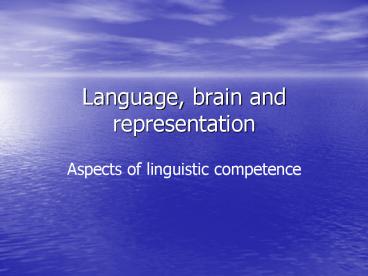Language, brain and representation - PowerPoint PPT Presentation
1 / 25
Title:
Language, brain and representation
Description:
The teacher refused the pupil's request because he was naughty. ... busy' : pragmatically more likely a property of teacher than pupil, but not lexically mandated. ... – PowerPoint PPT presentation
Number of Views:78
Avg rating:3.0/5.0
Title: Language, brain and representation
1
Language, brain and representation
- Aspects of linguistic competence
2
Language
- The most complex of human artifacts?
3
Three ways of viewing a language
- An internalized body of tacit knowledge (the
I language Chomsky) - A social construction or set of conventions
shared by a language community. - A natural object out there in the real world.
- Which of these three perspectives on language is
most relevant for our purposes?
4
Objectives of this module
- To specify the contents of an I-grammar.
- To specify what linguistics expressions are
composed of - The nature of word classes and phrase structure
- The recursive nature of grammatical rules that
underlie the generative power of human languages - The levels of organization that are found in
natural languages? - To give a hint of how linguistic forms map onto
meanings.
5
From the I-Language perspective
- The personal knowledge base that each speaker of
the language carries around in his/her head. - How can we access this knowledge?
- Introspection?
- Grammatical judgement?
- A grammar should generate all and only the
grammatical sentences of a language Chomsky. - The problem of subjectivity.
- The structuralist alternative to the
Internalist view 19th 20th century
Linguistic Science
6
From a structural linguists standpoint
- Linguistic structures are objects out there in
the real world of language usage. - The structures that linguists discover are
revealed in patterns of language usage habitual
collocations of phrases, words and sounds that
form nested patterns of sequential statistical
dependencies. (Bybee, 2002) - Our brains are sensitive analyzers of sequential
patterns of language input and output. - We react quickly very to departures from expected
sequences in the stream of spoken or written
language. - quickly very !
- This is the basis for syntactic anomaly
detection, a technique that may be used to assess
grammatical disorders or non-native competency.
7
Linguistic structures are only indirectly related
to meaning.
- Major word classes (noun, verb, etc.) cannot be
satisfactorily defined notionally, but only in
terms of their formal (distributional)
properties. - Some grammatical morphemes bear an obvious (but
imperfect) relationship to meaning categories - He looked unwell.
- but others, e.g. agreement do not
- He looks unwell. vs. They look unwell.
- Is there a reason for this degree of independence
of structure from meaning in natural language?
8
Independence of form and meaning in natural
language.
- Guarantees that syntactic structures may be
retrieved from distributional analysis of
language input by stochastic algorithm by
sequential learning mechanisms. - An important insight from Structural Linguistics
(Zellig Harris et al. 1940s-60), rejected by
Chomsky (1957), revived in the 1980s by
Connectionists (Rumelhart McClelland, PDP 1987,
Elman, 1986).
9
Is the meaning of a sentence fully determined by
its (syntactic) form and (lexical) content?
- Consider how the reference of he changes in 1.
and 2. - The teacher refused the pupils request because
he was naughty. - The teacher refused the pupils request because
he was busy. - What determines who he refers to?
10
Pragmatics knowledge of the world.
- Plays an important role in assigning meaning to
linguistic expressions. - In the previous example
- naughty applies only to subordinates. Hence,
the reading hepupil is favoured. A lexically
mandated reading. - busy pragmatically more likely a property of
teacher than pupil, but not lexically mandated.
11
How to define word classes
- What is a noun, verb, adjective?
- Notional vs distributional definitions of word
classes.
12
The advantage of a distributional approach to the
definition of word classes
- Provides a secure foundation for discovering or
inductively learning the syntactic structures of
any given language. - The downside of the distributional over the
notional approach to defining word classes is
that it complicates the mapping from sounds and
words to sentence meanings in linguistic
expressions.
13
Two exceptions to the indirect mapping between
sound and meaning
- Heuristic sentence processing,
- Direct mapping of form to meaning.
14
Heuristic sentence processing strategies
- May be used by the less than fully competent
speaker/listeners to map sentence form to
meaning. - The agent first strategy
- The cat chased the mouse.
- The mouse was chased by the cat.
- agent patient
15
Heuristics
- Over-simplified parsing strategies.
- Fail on many complex sentences.
- A kind of coping strategy?
- Jakobsons theory of aphasia.
16
Direct mapping from form to meaning the lexical
route.
- Used for word meaning and idioms.
- John kicked the bucket.
- This sentence is ambiguous
- ltJohn died.gt
- ltJohn kicked the bucketgt
- Which reading do you access first?
17
The lexicon
- An encyclopaedic store of form-meaning pairings.
- ...break the ice
- ...let the cat out of the bag
- Thats the way the cookie crumbles.
- May be smaller than a word
- ... unwanted ...
18
Minimal design features of a language
- A vocabulary (a lexicon) and a set of combinatory
rules for combining words into well-formed
expressions (sentences). - natural (human) languages require us to recognize
multiple levels of units. - How many levels?
19
Charles Hockett
- Double articulation of sound and meaning.
- Requires 4 levels of representation in human
languages - Phonemes, morphemes, words, sentences.
20
Linguistic expressions
21
Phonological representationat the segmental
level
22
Phonological representationat the word level
23
Phonological representationat the phrase level
24
Components of meaning categories of grammar
25
Thematic roles































